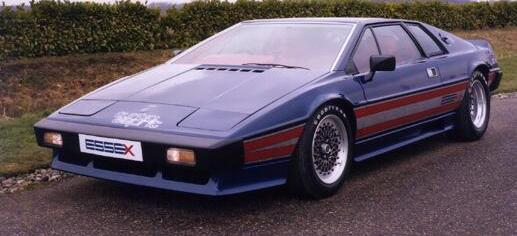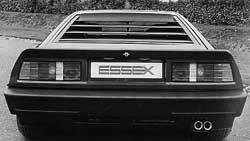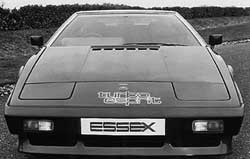

Essex Commemorative
Lotus Esprit Turbo
Lotus has joined the fashionable turbo brigade, not with its grand prix cars but with a new Esprit Turbo which was unveiled under bright lights and expected extravagance of a party hosted by Essex Petroleum in London’s Royal Albert Hall. Appropriately in these bustling days of commercialism, the new car’s birth certificate shows it to be the Essex Commemorative Lotus Esprit Turbo, production of which is to start in the spring of 1980 at the rate of ten a week. Only available finished in the Monte Carlo enterprise’s colours of blue, red and silver.
Though the car still carries the Esprit tag, its is effectively a new car and, apart from the competition orientated external changes, the real reason for the car’s birth comes from inside the multi-coloured exterior where the 16-valve engine has been punched out to 2,174cc, as in the Talbot Sunbeam Lotus, using a bore of 95.25mm, and stroke of 76.20mm. The four-cylinder aluminium engine provides a manufacturer’s claimed 210bhp at 6250rpm and 200lb ft of torque at 4500rpm. A Garrett T3 turbocharger which is mounted downstream of the twin Dellorto carburetters supplies boost up to 8psi and the engine operates on a 7.5:1 compression ratio. The downstream carburetion was chosen because Lotus believed it offered the advantages of improve throttle response, better air/fuel distribution and better wet fuel handling during starting. Lotus says the engine was designed to minimise the traditional problems of throttle lag and poor low speed torque that often trouble turbo engines – the problems being overcome by reducing the volumes of both the pre-turbine exhaust system and the induction system between the compressor and inlet valve. The turbocharger lubrication is direct from the main oil gallery, with rain to the dry sump, while the peak turbine speed is a cool 110,000rpm. The current Esprit five-speed gearbox has been retained and is attached to the engine block by a new alloy bell housing, while power is transmitted via a new clutch with increased capacity to the wheels via plunging constant velocity jointed driveshaft.
Maximum speeds in the various gears are 41.2 mph for first 62mph for second 91.1mph for third, 123.5mph for fourth and an inviting 152mph for fifth. Acceleration figures – supplied by Lotus – are 0-30 in 2.05secs, 0-40 in 2.85sec, 0-50 in 4.2secs, 0-60 in 5.55secs, 0-70 in 7.35 secs, 0-80 in 9.25 secs 0-90 in 11.185secs and 0-100 in 14.65 secs while a standing quarter-mile is offered in 14.4secs (98mph) and a standing kilometre in 26.1 secs (124mph).
The Esprit Turbo’s backbone chassis is completely new – zinc galvanised and with a five year guarantee subject to normal use – incorporating a wider front box section and suspension mounting points. A new space frame engine and transmission section is included, giving a four point wide-based mounting system and increased houses a new full-width radiator and oil cooler with increased capacity. The new front suspension has been adopted from the Elite, with the track increased by an inch, while the rear suspension is also revised, with unequal length transverse links with radius arms. Plunging driveshafts are used with new aluminium hub carriers, the track increased by 0.7". Ventilated brake discs were abandoned – the reason being they were found to be lacking "in feel and longevity" – in favour of a larger solid front disc than used on the Esprit S2, though the rear disc brake assembly from the S2 has been kept, but both brake master cylinder and servo have been made bigger.
The Esprit Turbo’s appealing exterior is, like the plush interior, the work to Giorgio Guigiaro at Ital Design – Guigiaro being, of course, the stylist of the Esprit S2. Bodyshell changes include large wrap-around front and rear bumpers, a full-width fronts spoiler for better air flow to the larger radiator/oil cooler and improved aerodynamics and a redesigned tailgate area to provide direct cooling airflow. NACA ducts have been moulded into the sills to provide cooling air into the engine compartment – which because of the redesigned chassis offers better access – because of the lack of turbulence beneath the car. A distinctive rear spoiler which incorporates tail lamp and registration plate housings is used to balance the car and give high speed stability. Guigiaro has retained the Esprit’s basic cockpit configuration though several detailed changes have been make including an instrument panel which now boasts a turbo boost gauge and speedometer running up to 170mph. Air conditioning controls are now situated in a centre console panel and all switch-gear is backlit when main and side lights are illuminated. A National Panasonic stereo/cassette radio unit is a standard feature of the Esprit Turbo and built into the roof of the car – two speakers being in the bulkhead behind the driver and passenger and two in the facia below the windscreen pillars. The seats have revised foam foundations and new head restraints while the standard interior trim is "fine tone" ruche stitched leather. Road wheels are three-piece composite alloy and fitted with Goodyear’s new performance ultra low profile NCT tyre – a steel belted VR performance tyre with elliptical sidewalls, straight circumferential grooved tread pattern and open radial shoulder channels.
A cheque in the region of £20,000 will enable you to drive off for some performance motoring in Colin Chapman’s latest addition to the sports car market.


|
|